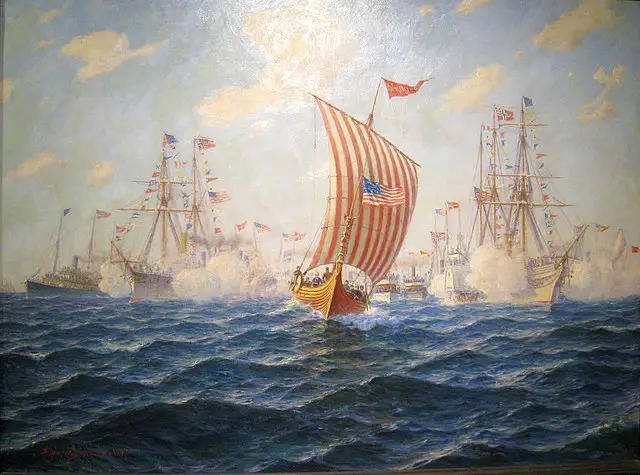Picture a long, sleek, dragon-headed ship, not a modern yacht or even a 19th-century schooner, but a Viking longship, hand-built with axes and wooden pegs, its sides smeared with tar, its sail billowing like something out of a Norse myth. Now imagine it sailing, not in a fjord or a reenactment fair, but across the actual Atlantic Ocean.
That happened.
In 1893.
Because one stubborn Norwegian decided to prove that the Vikings weren’t just good at raiding monasteries, they could’ve crossed oceans. On purpose. Long before Columbus even borrowed a boat.
Magnus Andersen: Viking Soul, Newspaper Job
So, who was this guy?
Magnus Andersen wasn’t a historian or a professor or a cosplay enthusiast. He was a newspaper editor. The kind of person who spends too much time around printing presses and gets ideas that sound like jokes until they become reality. He believed, deeply, that Viking ships were not only seaworthy but ocean-worthy, and that the Norse people had the tools and the guts to make it to North America long before Europeans were wearing pants with buttons.
This wasn’t just some wild patriotic hunch. In 1880, archaeologists in Norway unearthed the Gokstad ship, an almost fully intact Viking vessel buried in a mound near Sandefjord. And it changed everything. The craftsmanship was next-level. Long, light, fast, and flexible, it looked less like a crude raft and more like a Formula One car made of oak.
Andersen saw it and went, Okay. Let’s prove it.
Not in theory. Not in a paper. But by actually sailing one across the Atlantic.
Building the Viking: Not a Museum Piece, a Machine
Andersen wasn’t content to just model the ship. He built a full-scale, functional replica of the Gokstad vessel, using only the materials and methods that would’ve been available in the 9th century. No motors. No steel hull. No shortcuts.
They called it Viking. Clean name. No frills.
The ship was 78 feet long, 17 feet wide, and powered by a square sail and 16 pairs of oars. It had no cabin, so the crew was exposed to rain, wind, and the occasional seagull with boundary issues. It was beautiful, but also wildly impractical for modern ocean travel. Which was the point.
They weren’t trying to make it comfortable.
They were trying to make it real.
Atlantic Crossing: 28 Days of “We Might Die”
The Viking took 28 days to cross the Atlantic.
And it made it. Not barely. Not limping into harbor on the verge of collapse. The ship performed beautifully. The crew faced brutal weather, yes, but the vessel held. The design, nearly a thousand years old, proved to be not only seaworthy but efficient, fast, and incredibly stable in rough water.
Andersen’s theory? Vindicated.
The Vikings didn’t just raid Europe.
They sailed it. And beyond.
If you still think Leif Erikson showing up in North America was a happy accident, this journey suggests otherwise. These ships weren’t just for show. They were tools of expansion. Of discovery.
And maybe, just maybe, the Vikings knew exactly what they were doing.
So… What Happened Next?
Here’s where it gets a little bittersweet.
After the fair, the excitement faded. The Viking was put into storage. Then it sat in a park. Then it was moved, forgotten, and left to decay in a shed behind the Museum of Science and Industry. For decades. Rain poured through the roof. Paint peeled. Rats nested.
Eventually, it was rescued and restored. Today, it lives in Geneva, Illinois — indoors, finally — under the care of volunteers who are still fighting to preserve its memory.
But most people still don’t know this story.
They don’t know that a Viking ship crossed the Atlantic in 1893 to prove history wrong.
And succeeded.
Sources:
1. Viking longships – Wikipedia

